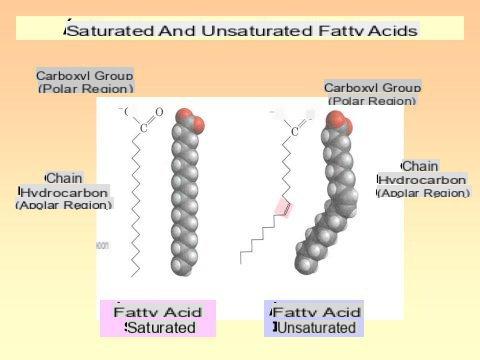
Talking about fats always makes you think about flesh. True. However, there are "families" of fats that are good for your health and others that seriously harm you.
The topic is a bit specific but, trust me, it's worth following. Let's deepen our knowledge on fatty acids, what they are and how they differ, good and bad.
Fatty acids: what they are
By definition, fatty acid molecules are long carbon and hydrogen chains with a carboxylic group (symbol -COOH), which gives the characteristic of "acid", just like acetic acid, yes, that of vinegar, to understand.
What does this have to do with fats, you ask? Fatty acids have very long chains and, if they bind (chemically) three molecules of fatty acids with one of glycerol i are formed triglycerides, the very ones we don't want to get high, when we read our blood tests!
The different length of the chains and the presence of specific chemical bonds mean that there are various types of fatty acids, with various healthy properties or not, and with different consistencies (liquid or solid at room temperature).
The first difference is the classification in saturated and unsaturated fatty acids, relating to the presence or absence of double bonds between carbon molecules.
Further subdivisions are made based on:
- to the length of the chains: corta, with less than 6 carbon atoms; average, between 6 and 12 carbon atoms; long, between 12 and 20 carbon atoms; very long, with more than 20 carbon atoms
- to the three-dimensional shape: isomers "Are you there"or"tranny"depending on how the chains after the double bond are arranged in space.
In our body fatty acids are very present in free form, as part of the reactions of the metabolism, but mostly in the form of triglycerides.
Essential fatty acids and seeds
How fatty acids differ: saturated (the bad)
Here the "black sheep" of the family. They are not bad at all, in that these fatty acids are sources of energy; the problem is theirs abundance in our diet today, which leads to an accumulation of fat in the adipose tissue (yes, the flab), with increased risk of obesity e cardiovascular problems such as for example atherosclerosis (it is called atherogenic effect).
There are stable molecules, which oxidize only at very high temperatures.
Fatty acids short chain saturated are liquids at room temperature; in free form they smell bad. I am present in milk and easily digestible. Common names: acid butyric, capric, caprilic, caprinic.
Saturated fatty acids a long chain instead they are solid at room temperature, they are less digestible and more common in animal fats. Some examples: acid myristic, stearic (which, however, easily converts to oleic acid, unsaturated) palmitic. Palmitic acid is contained inPalm oil, in lard, in lard: could it be for this reason that nutritionists advise against palm oil?
How fatty acids differ: unsaturated (the good or almost)
- unsaturated fatty acids are distinguished by the presence of one (mono unsaturated) or more (polyunsaturated) double bonds between the carbon atoms on the chain. The numbering of the carbon atoms starts from the number one in the "head" and progresses towards the "tail" that is the COOH carboxylic group.
The carbon atom on which the first double bond is present, starting from the "bottom" of the molecule, is characterized by a number after the letter omega... Here we should enter known territory. The name tells you nothing Omega-3? We're getting there!
Fatty acids monounsaturated I am for example theoleic acid (present in a share of 75% in olive oil): difficult to oxidize at room temperature and therefore well preserved, protect the arteries from cardiovascular problems.
Fatty acids polyunsaturated are distinguished by the presence of double bonds, on the same side of the chain (it is called "forma in cis") or from opposite sides (it is called "trans form"). The shapes tranny have the same morphology as the saturated fats, therefore, like them, they are poorly recommended for health.
Trans fatty acids are present in milk and cheese, are typical of so-called hydrogenated vegetable oils artificially, for example those contained in the margarine. They can be deposited in our adipose tissue, on the arteries and raise cholesterol levels, as well as the risk of atherosclerosis.
Among the fatty acids polyunsaturated the essential fatty acids, that is, those that our body is not able to synthesize by itself and which therefore must be introduced with thesupply. They are mainly two: linoleic acid (from which our body produces Omega-6 fatty acids) and acid Alfa-linolenico (Omega-3 "householder").
Characteristics of the Omega-6 fatty acids: they oxidize easily; if consumed in excess (compared to Omega-3) they decrease both "bad" LDL and "good" HDL cholesterol; in our body they preside over the chemical mechanisms that lead to inflammation and the risk of thrombosis from aggregation of platelets. They are rich in Omega-6 fatty acids, grapeseed oil, corn and soybean oil, nuts.
Characteristics of the Omega-3 fatty acids: they oxidize easily (therefore it is difficult to keep them long); intervene in anti-inflammatory processes of our body; decrease platelet aggregation and therefore the risk of thrombosis. They are rich in Omega-3 l fatty acids nights and their oil, the linseed and their oil, the fish of the cold seas and our "blue fish".
Seasoning fats: which ones to prefer?


























